Gender Pay Gap: Evaluating Pay Inequalities in Organizations
VerifiedAdded on 2022/08/28
|21
|6263
|12
Essay
AI Summary
This essay delves into the persistent issue of the gender pay gap, exploring its definition, prevalence, and impact on organizations. It begins by defining the gender pay gap and highlighting its continued existence despite legal measures. The essay analyzes a case study involving Lily Ledbetter, illustrating the challenges women face in addressing pay discrimination. It examines the reasons behind pay inequalities, emphasizing the importance of fair pay structures and the role of the Equal Pay Act. The essay further discusses theoretical approaches, including labor market discrimination and human capital models, to explain the gender pay gap. Ultimately, the essay underscores the need for organizations to address pay disparities to improve productivity, attract talent, and comply with legal and ethical standards.

Running head: GENDER PAY GAP
Gender Pay Gap
Name of the Student:
Name of the University:
Author note:
Gender Pay Gap
Name of the Student:
Name of the University:
Author note:
Paraphrase This Document
Need a fresh take? Get an instant paraphrase of this document with our AI Paraphraser
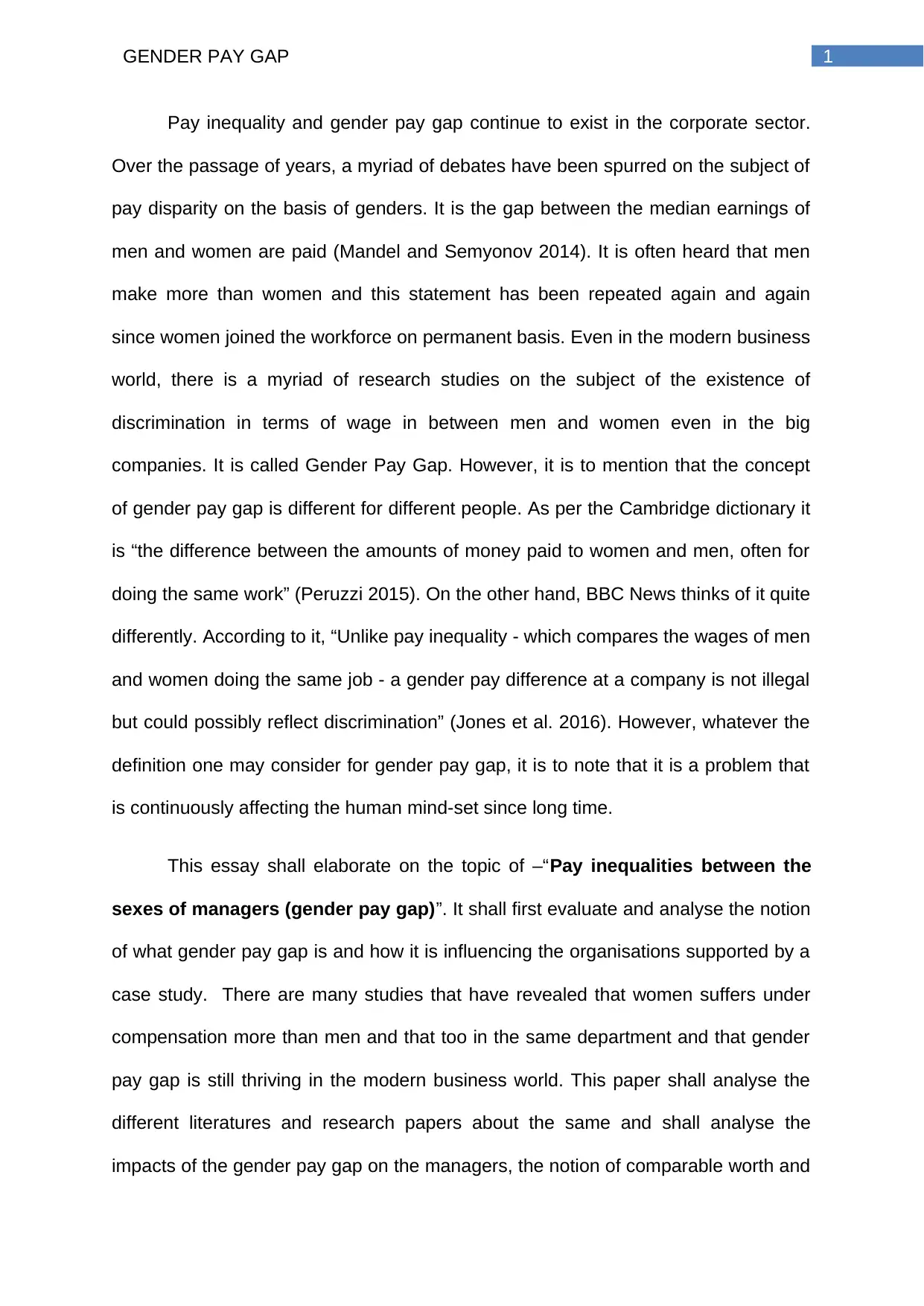
1GENDER PAY GAP
Pay inequality and gender pay gap continue to exist in the corporate sector.
Over the passage of years, a myriad of debates have been spurred on the subject of
pay disparity on the basis of genders. It is the gap between the median earnings of
men and women are paid (Mandel and Semyonov 2014). It is often heard that men
make more than women and this statement has been repeated again and again
since women joined the workforce on permanent basis. Even in the modern business
world, there is a myriad of research studies on the subject of the existence of
discrimination in terms of wage in between men and women even in the big
companies. It is called Gender Pay Gap. However, it is to mention that the concept
of gender pay gap is different for different people. As per the Cambridge dictionary it
is “the difference between the amounts of money paid to women and men, often for
doing the same work” (Peruzzi 2015). On the other hand, BBC News thinks of it quite
differently. According to it, “Unlike pay inequality - which compares the wages of men
and women doing the same job - a gender pay difference at a company is not illegal
but could possibly reflect discrimination” (Jones et al. 2016). However, whatever the
definition one may consider for gender pay gap, it is to note that it is a problem that
is continuously affecting the human mind-set since long time.
This essay shall elaborate on the topic of –“Pay inequalities between the
sexes of managers (gender pay gap)”. It shall first evaluate and analyse the notion
of what gender pay gap is and how it is influencing the organisations supported by a
case study. There are many studies that have revealed that women suffers under
compensation more than men and that too in the same department and that gender
pay gap is still thriving in the modern business world. This paper shall analyse the
different literatures and research papers about the same and shall analyse the
impacts of the gender pay gap on the managers, the notion of comparable worth and
Pay inequality and gender pay gap continue to exist in the corporate sector.
Over the passage of years, a myriad of debates have been spurred on the subject of
pay disparity on the basis of genders. It is the gap between the median earnings of
men and women are paid (Mandel and Semyonov 2014). It is often heard that men
make more than women and this statement has been repeated again and again
since women joined the workforce on permanent basis. Even in the modern business
world, there is a myriad of research studies on the subject of the existence of
discrimination in terms of wage in between men and women even in the big
companies. It is called Gender Pay Gap. However, it is to mention that the concept
of gender pay gap is different for different people. As per the Cambridge dictionary it
is “the difference between the amounts of money paid to women and men, often for
doing the same work” (Peruzzi 2015). On the other hand, BBC News thinks of it quite
differently. According to it, “Unlike pay inequality - which compares the wages of men
and women doing the same job - a gender pay difference at a company is not illegal
but could possibly reflect discrimination” (Jones et al. 2016). However, whatever the
definition one may consider for gender pay gap, it is to note that it is a problem that
is continuously affecting the human mind-set since long time.
This essay shall elaborate on the topic of –“Pay inequalities between the
sexes of managers (gender pay gap)”. It shall first evaluate and analyse the notion
of what gender pay gap is and how it is influencing the organisations supported by a
case study. There are many studies that have revealed that women suffers under
compensation more than men and that too in the same department and that gender
pay gap is still thriving in the modern business world. This paper shall analyse the
different literatures and research papers about the same and shall analyse the
impacts of the gender pay gap on the managers, the notion of comparable worth and
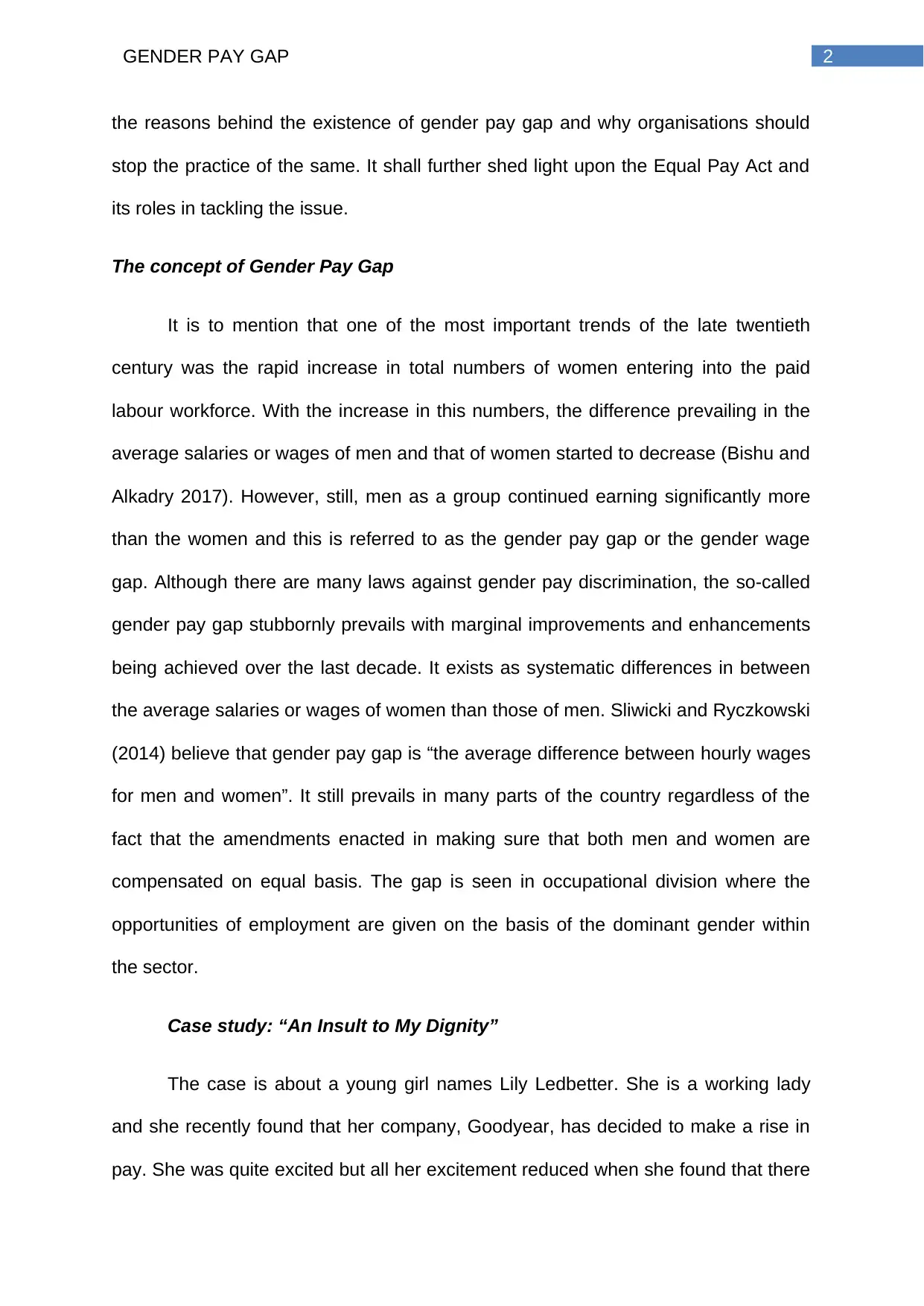
2GENDER PAY GAP
the reasons behind the existence of gender pay gap and why organisations should
stop the practice of the same. It shall further shed light upon the Equal Pay Act and
its roles in tackling the issue.
The concept of Gender Pay Gap
It is to mention that one of the most important trends of the late twentieth
century was the rapid increase in total numbers of women entering into the paid
labour workforce. With the increase in this numbers, the difference prevailing in the
average salaries or wages of men and that of women started to decrease (Bishu and
Alkadry 2017). However, still, men as a group continued earning significantly more
than the women and this is referred to as the gender pay gap or the gender wage
gap. Although there are many laws against gender pay discrimination, the so-called
gender pay gap stubbornly prevails with marginal improvements and enhancements
being achieved over the last decade. It exists as systematic differences in between
the average salaries or wages of women than those of men. Sliwicki and Ryczkowski
(2014) believe that gender pay gap is “the average difference between hourly wages
for men and women”. It still prevails in many parts of the country regardless of the
fact that the amendments enacted in making sure that both men and women are
compensated on equal basis. The gap is seen in occupational division where the
opportunities of employment are given on the basis of the dominant gender within
the sector.
Case study: “An Insult to My Dignity”
The case is about a young girl names Lily Ledbetter. She is a working lady
and she recently found that her company, Goodyear, has decided to make a rise in
pay. She was quite excited but all her excitement reduced when she found that there
the reasons behind the existence of gender pay gap and why organisations should
stop the practice of the same. It shall further shed light upon the Equal Pay Act and
its roles in tackling the issue.
The concept of Gender Pay Gap
It is to mention that one of the most important trends of the late twentieth
century was the rapid increase in total numbers of women entering into the paid
labour workforce. With the increase in this numbers, the difference prevailing in the
average salaries or wages of men and that of women started to decrease (Bishu and
Alkadry 2017). However, still, men as a group continued earning significantly more
than the women and this is referred to as the gender pay gap or the gender wage
gap. Although there are many laws against gender pay discrimination, the so-called
gender pay gap stubbornly prevails with marginal improvements and enhancements
being achieved over the last decade. It exists as systematic differences in between
the average salaries or wages of women than those of men. Sliwicki and Ryczkowski
(2014) believe that gender pay gap is “the average difference between hourly wages
for men and women”. It still prevails in many parts of the country regardless of the
fact that the amendments enacted in making sure that both men and women are
compensated on equal basis. The gap is seen in occupational division where the
opportunities of employment are given on the basis of the dominant gender within
the sector.
Case study: “An Insult to My Dignity”
The case is about a young girl names Lily Ledbetter. She is a working lady
and she recently found that her company, Goodyear, has decided to make a rise in
pay. She was quite excited but all her excitement reduced when she found that there
⊘ This is a preview!⊘
Do you want full access?
Subscribe today to unlock all pages.

Trusted by 1+ million students worldwide
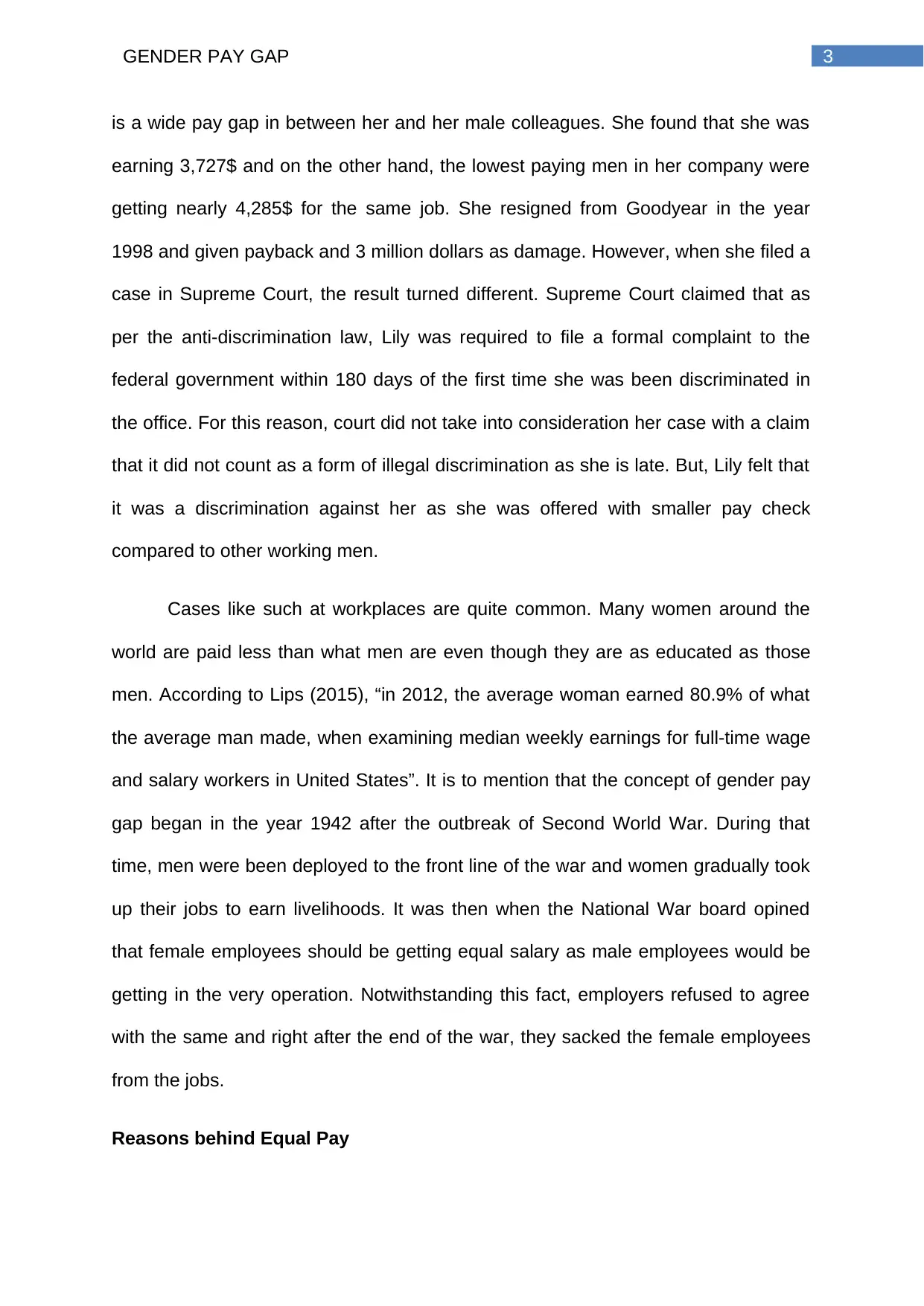
3GENDER PAY GAP
is a wide pay gap in between her and her male colleagues. She found that she was
earning 3,727$ and on the other hand, the lowest paying men in her company were
getting nearly 4,285$ for the same job. She resigned from Goodyear in the year
1998 and given payback and 3 million dollars as damage. However, when she filed a
case in Supreme Court, the result turned different. Supreme Court claimed that as
per the anti-discrimination law, Lily was required to file a formal complaint to the
federal government within 180 days of the first time she was been discriminated in
the office. For this reason, court did not take into consideration her case with a claim
that it did not count as a form of illegal discrimination as she is late. But, Lily felt that
it was a discrimination against her as she was offered with smaller pay check
compared to other working men.
Cases like such at workplaces are quite common. Many women around the
world are paid less than what men are even though they are as educated as those
men. According to Lips (2015), “in 2012, the average woman earned 80.9% of what
the average man made, when examining median weekly earnings for full-time wage
and salary workers in United States”. It is to mention that the concept of gender pay
gap began in the year 1942 after the outbreak of Second World War. During that
time, men were been deployed to the front line of the war and women gradually took
up their jobs to earn livelihoods. It was then when the National War board opined
that female employees should be getting equal salary as male employees would be
getting in the very operation. Notwithstanding this fact, employers refused to agree
with the same and right after the end of the war, they sacked the female employees
from the jobs.
Reasons behind Equal Pay
is a wide pay gap in between her and her male colleagues. She found that she was
earning 3,727$ and on the other hand, the lowest paying men in her company were
getting nearly 4,285$ for the same job. She resigned from Goodyear in the year
1998 and given payback and 3 million dollars as damage. However, when she filed a
case in Supreme Court, the result turned different. Supreme Court claimed that as
per the anti-discrimination law, Lily was required to file a formal complaint to the
federal government within 180 days of the first time she was been discriminated in
the office. For this reason, court did not take into consideration her case with a claim
that it did not count as a form of illegal discrimination as she is late. But, Lily felt that
it was a discrimination against her as she was offered with smaller pay check
compared to other working men.
Cases like such at workplaces are quite common. Many women around the
world are paid less than what men are even though they are as educated as those
men. According to Lips (2015), “in 2012, the average woman earned 80.9% of what
the average man made, when examining median weekly earnings for full-time wage
and salary workers in United States”. It is to mention that the concept of gender pay
gap began in the year 1942 after the outbreak of Second World War. During that
time, men were been deployed to the front line of the war and women gradually took
up their jobs to earn livelihoods. It was then when the National War board opined
that female employees should be getting equal salary as male employees would be
getting in the very operation. Notwithstanding this fact, employers refused to agree
with the same and right after the end of the war, they sacked the female employees
from the jobs.
Reasons behind Equal Pay
Paraphrase This Document
Need a fresh take? Get an instant paraphrase of this document with our AI Paraphraser
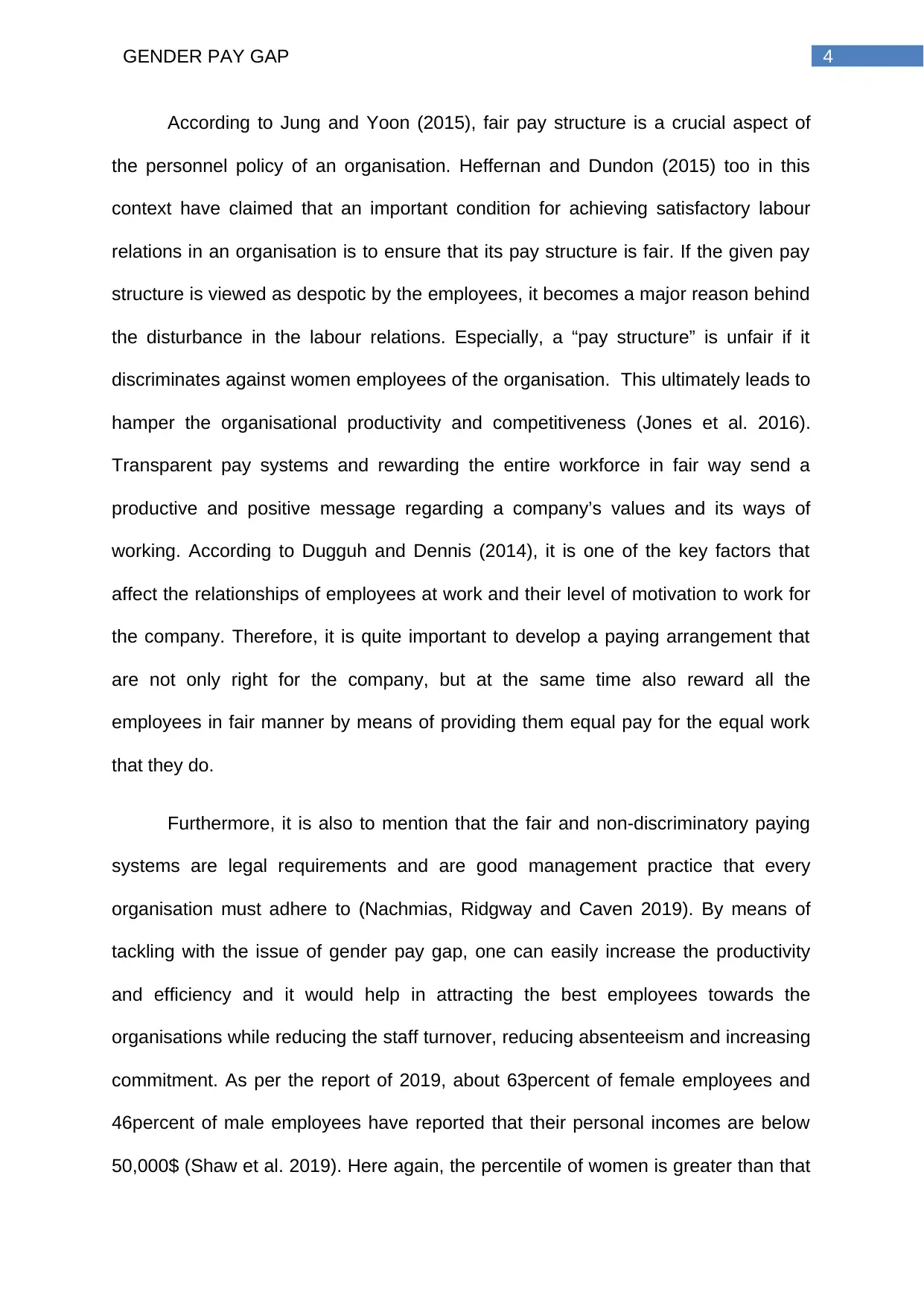
4GENDER PAY GAP
According to Jung and Yoon (2015), fair pay structure is a crucial aspect of
the personnel policy of an organisation. Heffernan and Dundon (2015) too in this
context have claimed that an important condition for achieving satisfactory labour
relations in an organisation is to ensure that its pay structure is fair. If the given pay
structure is viewed as despotic by the employees, it becomes a major reason behind
the disturbance in the labour relations. Especially, a “pay structure” is unfair if it
discriminates against women employees of the organisation. This ultimately leads to
hamper the organisational productivity and competitiveness (Jones et al. 2016).
Transparent pay systems and rewarding the entire workforce in fair way send a
productive and positive message regarding a company’s values and its ways of
working. According to Dugguh and Dennis (2014), it is one of the key factors that
affect the relationships of employees at work and their level of motivation to work for
the company. Therefore, it is quite important to develop a paying arrangement that
are not only right for the company, but at the same time also reward all the
employees in fair manner by means of providing them equal pay for the equal work
that they do.
Furthermore, it is also to mention that the fair and non-discriminatory paying
systems are legal requirements and are good management practice that every
organisation must adhere to (Nachmias, Ridgway and Caven 2019). By means of
tackling with the issue of gender pay gap, one can easily increase the productivity
and efficiency and it would help in attracting the best employees towards the
organisations while reducing the staff turnover, reducing absenteeism and increasing
commitment. As per the report of 2019, about 63percent of female employees and
46percent of male employees have reported that their personal incomes are below
50,000$ (Shaw et al. 2019). Here again, the percentile of women is greater than that
According to Jung and Yoon (2015), fair pay structure is a crucial aspect of
the personnel policy of an organisation. Heffernan and Dundon (2015) too in this
context have claimed that an important condition for achieving satisfactory labour
relations in an organisation is to ensure that its pay structure is fair. If the given pay
structure is viewed as despotic by the employees, it becomes a major reason behind
the disturbance in the labour relations. Especially, a “pay structure” is unfair if it
discriminates against women employees of the organisation. This ultimately leads to
hamper the organisational productivity and competitiveness (Jones et al. 2016).
Transparent pay systems and rewarding the entire workforce in fair way send a
productive and positive message regarding a company’s values and its ways of
working. According to Dugguh and Dennis (2014), it is one of the key factors that
affect the relationships of employees at work and their level of motivation to work for
the company. Therefore, it is quite important to develop a paying arrangement that
are not only right for the company, but at the same time also reward all the
employees in fair manner by means of providing them equal pay for the equal work
that they do.
Furthermore, it is also to mention that the fair and non-discriminatory paying
systems are legal requirements and are good management practice that every
organisation must adhere to (Nachmias, Ridgway and Caven 2019). By means of
tackling with the issue of gender pay gap, one can easily increase the productivity
and efficiency and it would help in attracting the best employees towards the
organisations while reducing the staff turnover, reducing absenteeism and increasing
commitment. As per the report of 2019, about 63percent of female employees and
46percent of male employees have reported that their personal incomes are below
50,000$ (Shaw et al. 2019). Here again, the percentile of women is greater than that

5GENDER PAY GAP
of men. It should be noted that equal-pay is a key part of CSR activity of a company.
It is highly vital for the stakeholders. Failure to make sure that equal pay can result in
some legal claims and reputational damage, which would ultimately affect the
commercial success of the company negatively.
Equal Pay Act
The world-wide labour force has long been a made dominated dimension and
during 1940s, the then jobs were advertised on the basis of gender (Siniscalco,
Damrell and Nabity 2014). High salaried managerial position jobs were secluded for
the males regardless of the fact that often the other gender has the potential of
occupying the job more than the males. The then two-tiered scale used to ascertain
that males were the priority and they were compensated more than the females. It
was not until 1944 when Rep. Winfred Stanley proposed the first ever bill that
demanded National Labour Relations Act for abolishing the gender pay gap.
Again, in the year 1950, Katherine St. George proposed a bill, that granted the
amendment of Equal Rights for both men and women (Garben 2018).
Notwithstanding this, the bill failed initially but St. George stayed determined on his
believe that women are more likely to change the economic status of the country in
positive way if they were given the chance. Finally, in the year 1963, President John
Kennedy signed the Equal Pay Act and it was formalised since the beginning of
1964.
It is to mention that the Equal Pay Act outlaws the system of wage prejudice
on the basis of gender and it emphasises on the notion that both men and women
should be paid equally for the works that are done under similar conditions. The
concept of equal compensation comprises of bonuses, salaries and other holiday
of men. It should be noted that equal-pay is a key part of CSR activity of a company.
It is highly vital for the stakeholders. Failure to make sure that equal pay can result in
some legal claims and reputational damage, which would ultimately affect the
commercial success of the company negatively.
Equal Pay Act
The world-wide labour force has long been a made dominated dimension and
during 1940s, the then jobs were advertised on the basis of gender (Siniscalco,
Damrell and Nabity 2014). High salaried managerial position jobs were secluded for
the males regardless of the fact that often the other gender has the potential of
occupying the job more than the males. The then two-tiered scale used to ascertain
that males were the priority and they were compensated more than the females. It
was not until 1944 when Rep. Winfred Stanley proposed the first ever bill that
demanded National Labour Relations Act for abolishing the gender pay gap.
Again, in the year 1950, Katherine St. George proposed a bill, that granted the
amendment of Equal Rights for both men and women (Garben 2018).
Notwithstanding this, the bill failed initially but St. George stayed determined on his
believe that women are more likely to change the economic status of the country in
positive way if they were given the chance. Finally, in the year 1963, President John
Kennedy signed the Equal Pay Act and it was formalised since the beginning of
1964.
It is to mention that the Equal Pay Act outlaws the system of wage prejudice
on the basis of gender and it emphasises on the notion that both men and women
should be paid equally for the works that are done under similar conditions. The
concept of equal compensation comprises of bonuses, salaries and other holiday
⊘ This is a preview!⊘
Do you want full access?
Subscribe today to unlock all pages.

Trusted by 1+ million students worldwide
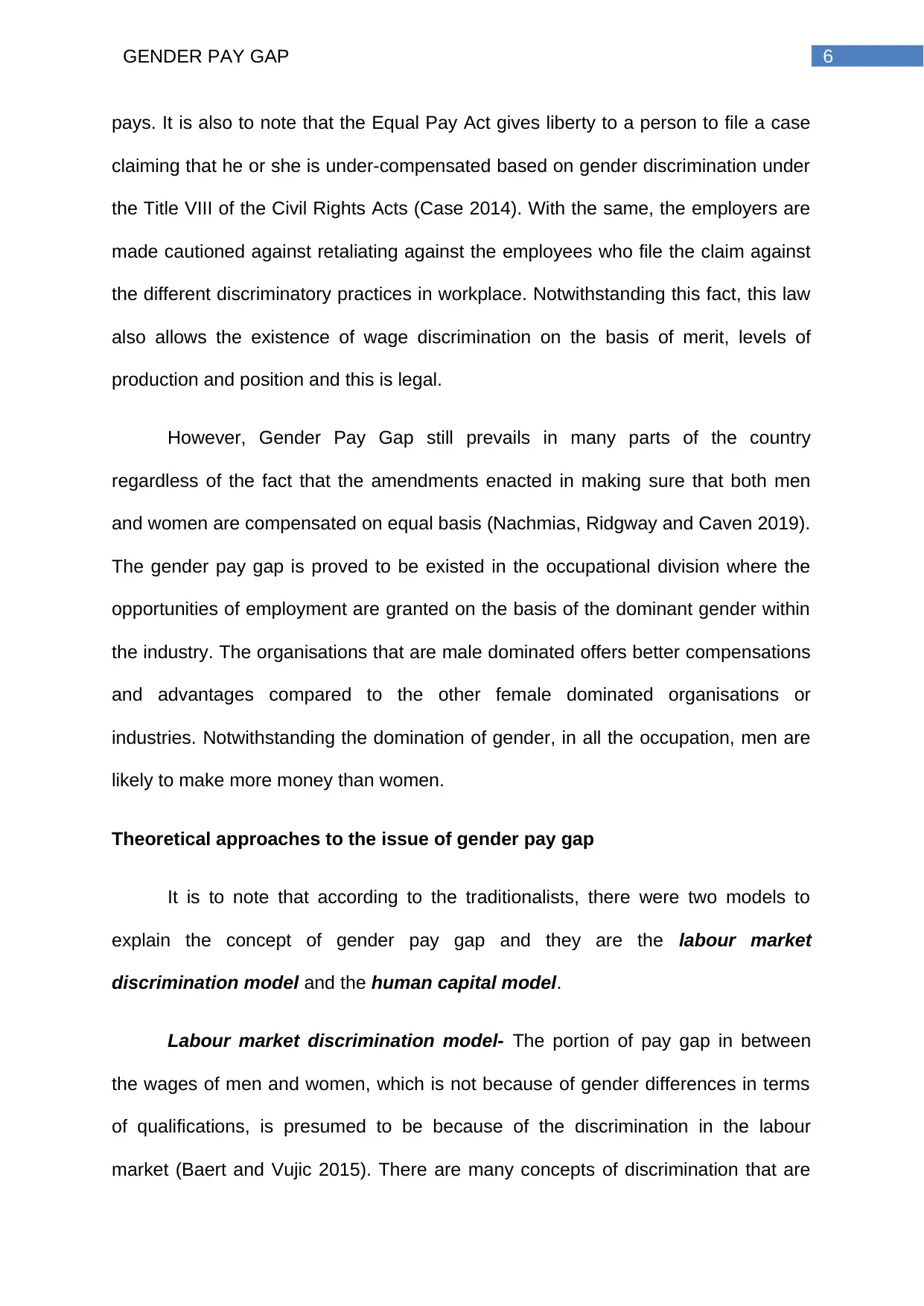
6GENDER PAY GAP
pays. It is also to note that the Equal Pay Act gives liberty to a person to file a case
claiming that he or she is under-compensated based on gender discrimination under
the Title VIII of the Civil Rights Acts (Case 2014). With the same, the employers are
made cautioned against retaliating against the employees who file the claim against
the different discriminatory practices in workplace. Notwithstanding this fact, this law
also allows the existence of wage discrimination on the basis of merit, levels of
production and position and this is legal.
However, Gender Pay Gap still prevails in many parts of the country
regardless of the fact that the amendments enacted in making sure that both men
and women are compensated on equal basis (Nachmias, Ridgway and Caven 2019).
The gender pay gap is proved to be existed in the occupational division where the
opportunities of employment are granted on the basis of the dominant gender within
the industry. The organisations that are male dominated offers better compensations
and advantages compared to the other female dominated organisations or
industries. Notwithstanding the domination of gender, in all the occupation, men are
likely to make more money than women.
Theoretical approaches to the issue of gender pay gap
It is to note that according to the traditionalists, there were two models to
explain the concept of gender pay gap and they are the labour market
discrimination model and the human capital model.
Labour market discrimination model- The portion of pay gap in between
the wages of men and women, which is not because of gender differences in terms
of qualifications, is presumed to be because of the discrimination in the labour
market (Baert and Vujic 2015). There are many concepts of discrimination that are
pays. It is also to note that the Equal Pay Act gives liberty to a person to file a case
claiming that he or she is under-compensated based on gender discrimination under
the Title VIII of the Civil Rights Acts (Case 2014). With the same, the employers are
made cautioned against retaliating against the employees who file the claim against
the different discriminatory practices in workplace. Notwithstanding this fact, this law
also allows the existence of wage discrimination on the basis of merit, levels of
production and position and this is legal.
However, Gender Pay Gap still prevails in many parts of the country
regardless of the fact that the amendments enacted in making sure that both men
and women are compensated on equal basis (Nachmias, Ridgway and Caven 2019).
The gender pay gap is proved to be existed in the occupational division where the
opportunities of employment are granted on the basis of the dominant gender within
the industry. The organisations that are male dominated offers better compensations
and advantages compared to the other female dominated organisations or
industries. Notwithstanding the domination of gender, in all the occupation, men are
likely to make more money than women.
Theoretical approaches to the issue of gender pay gap
It is to note that according to the traditionalists, there were two models to
explain the concept of gender pay gap and they are the labour market
discrimination model and the human capital model.
Labour market discrimination model- The portion of pay gap in between
the wages of men and women, which is not because of gender differences in terms
of qualifications, is presumed to be because of the discrimination in the labour
market (Baert and Vujic 2015). There are many concepts of discrimination that are
Paraphrase This Document
Need a fresh take? Get an instant paraphrase of this document with our AI Paraphraser
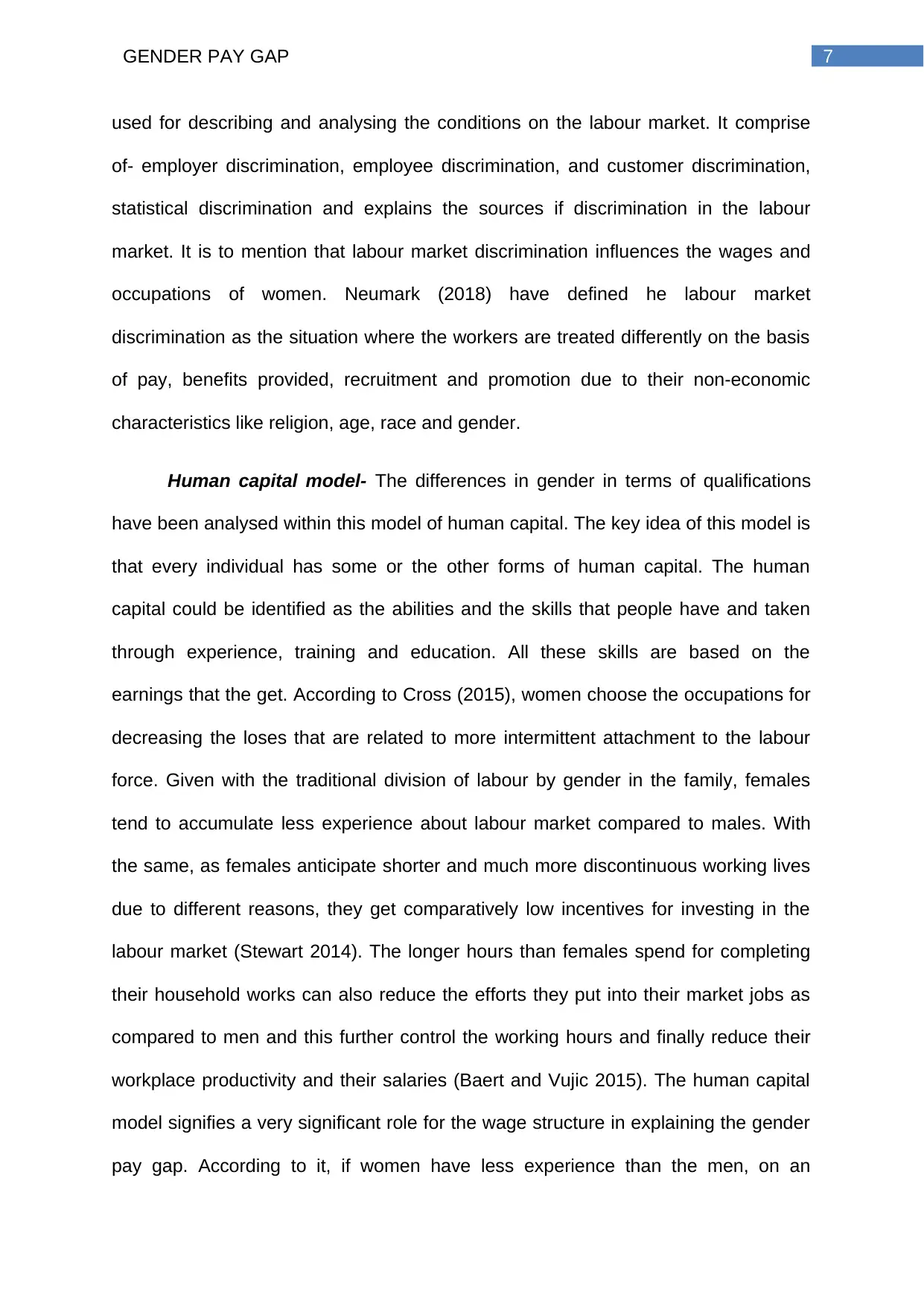
7GENDER PAY GAP
used for describing and analysing the conditions on the labour market. It comprise
of- employer discrimination, employee discrimination, and customer discrimination,
statistical discrimination and explains the sources if discrimination in the labour
market. It is to mention that labour market discrimination influences the wages and
occupations of women. Neumark (2018) have defined he labour market
discrimination as the situation where the workers are treated differently on the basis
of pay, benefits provided, recruitment and promotion due to their non-economic
characteristics like religion, age, race and gender.
Human capital model- The differences in gender in terms of qualifications
have been analysed within this model of human capital. The key idea of this model is
that every individual has some or the other forms of human capital. The human
capital could be identified as the abilities and the skills that people have and taken
through experience, training and education. All these skills are based on the
earnings that the get. According to Cross (2015), women choose the occupations for
decreasing the loses that are related to more intermittent attachment to the labour
force. Given with the traditional division of labour by gender in the family, females
tend to accumulate less experience about labour market compared to males. With
the same, as females anticipate shorter and much more discontinuous working lives
due to different reasons, they get comparatively low incentives for investing in the
labour market (Stewart 2014). The longer hours than females spend for completing
their household works can also reduce the efforts they put into their market jobs as
compared to men and this further control the working hours and finally reduce their
workplace productivity and their salaries (Baert and Vujic 2015). The human capital
model signifies a very significant role for the wage structure in explaining the gender
pay gap. According to it, if women have less experience than the men, on an
used for describing and analysing the conditions on the labour market. It comprise
of- employer discrimination, employee discrimination, and customer discrimination,
statistical discrimination and explains the sources if discrimination in the labour
market. It is to mention that labour market discrimination influences the wages and
occupations of women. Neumark (2018) have defined he labour market
discrimination as the situation where the workers are treated differently on the basis
of pay, benefits provided, recruitment and promotion due to their non-economic
characteristics like religion, age, race and gender.
Human capital model- The differences in gender in terms of qualifications
have been analysed within this model of human capital. The key idea of this model is
that every individual has some or the other forms of human capital. The human
capital could be identified as the abilities and the skills that people have and taken
through experience, training and education. All these skills are based on the
earnings that the get. According to Cross (2015), women choose the occupations for
decreasing the loses that are related to more intermittent attachment to the labour
force. Given with the traditional division of labour by gender in the family, females
tend to accumulate less experience about labour market compared to males. With
the same, as females anticipate shorter and much more discontinuous working lives
due to different reasons, they get comparatively low incentives for investing in the
labour market (Stewart 2014). The longer hours than females spend for completing
their household works can also reduce the efforts they put into their market jobs as
compared to men and this further control the working hours and finally reduce their
workplace productivity and their salaries (Baert and Vujic 2015). The human capital
model signifies a very significant role for the wage structure in explaining the gender
pay gap. According to it, if women have less experience than the men, on an
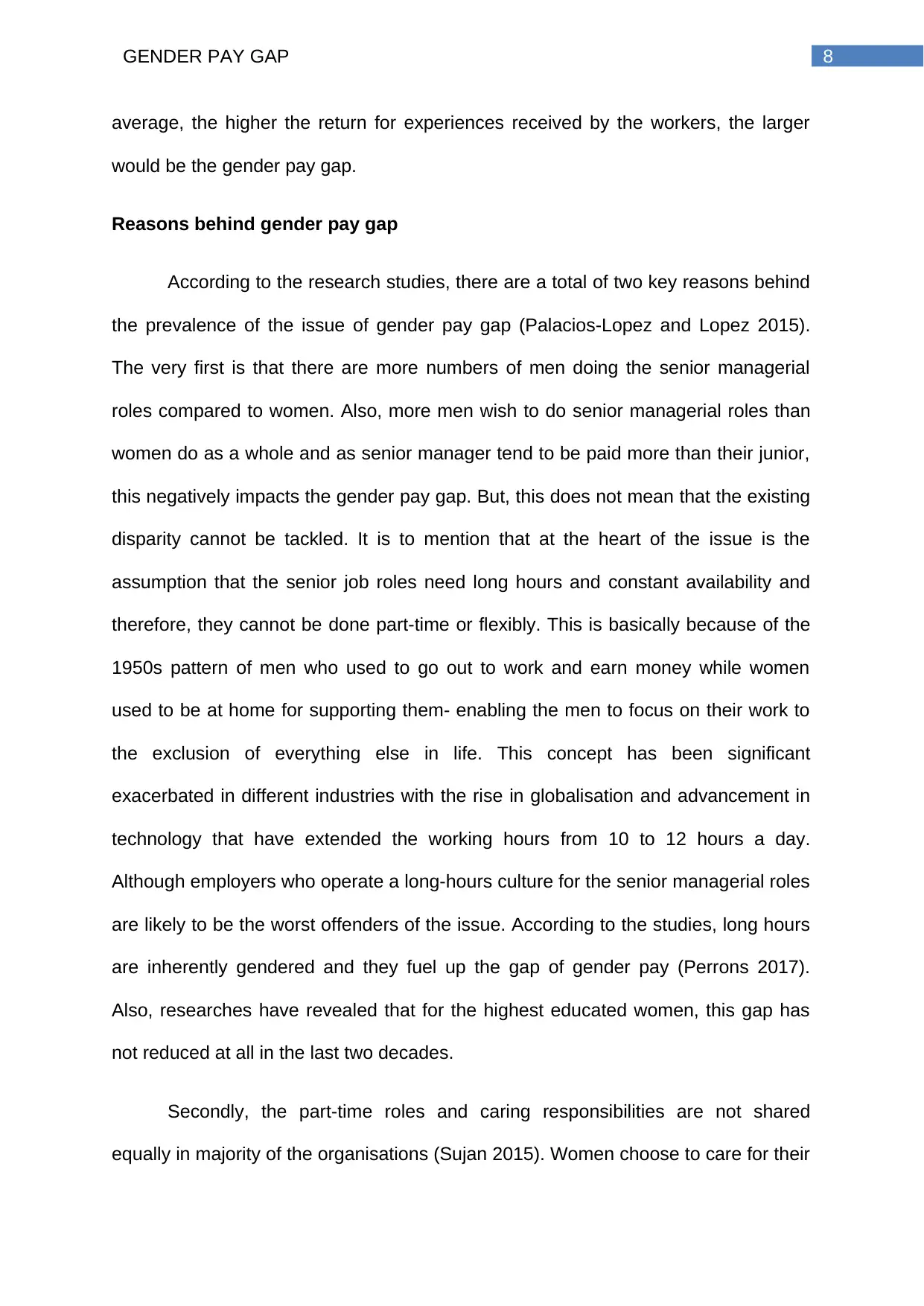
8GENDER PAY GAP
average, the higher the return for experiences received by the workers, the larger
would be the gender pay gap.
Reasons behind gender pay gap
According to the research studies, there are a total of two key reasons behind
the prevalence of the issue of gender pay gap (Palacios-Lopez and Lopez 2015).
The very first is that there are more numbers of men doing the senior managerial
roles compared to women. Also, more men wish to do senior managerial roles than
women do as a whole and as senior manager tend to be paid more than their junior,
this negatively impacts the gender pay gap. But, this does not mean that the existing
disparity cannot be tackled. It is to mention that at the heart of the issue is the
assumption that the senior job roles need long hours and constant availability and
therefore, they cannot be done part-time or flexibly. This is basically because of the
1950s pattern of men who used to go out to work and earn money while women
used to be at home for supporting them- enabling the men to focus on their work to
the exclusion of everything else in life. This concept has been significant
exacerbated in different industries with the rise in globalisation and advancement in
technology that have extended the working hours from 10 to 12 hours a day.
Although employers who operate a long-hours culture for the senior managerial roles
are likely to be the worst offenders of the issue. According to the studies, long hours
are inherently gendered and they fuel up the gap of gender pay (Perrons 2017).
Also, researches have revealed that for the highest educated women, this gap has
not reduced at all in the last two decades.
Secondly, the part-time roles and caring responsibilities are not shared
equally in majority of the organisations (Sujan 2015). Women choose to care for their
average, the higher the return for experiences received by the workers, the larger
would be the gender pay gap.
Reasons behind gender pay gap
According to the research studies, there are a total of two key reasons behind
the prevalence of the issue of gender pay gap (Palacios-Lopez and Lopez 2015).
The very first is that there are more numbers of men doing the senior managerial
roles compared to women. Also, more men wish to do senior managerial roles than
women do as a whole and as senior manager tend to be paid more than their junior,
this negatively impacts the gender pay gap. But, this does not mean that the existing
disparity cannot be tackled. It is to mention that at the heart of the issue is the
assumption that the senior job roles need long hours and constant availability and
therefore, they cannot be done part-time or flexibly. This is basically because of the
1950s pattern of men who used to go out to work and earn money while women
used to be at home for supporting them- enabling the men to focus on their work to
the exclusion of everything else in life. This concept has been significant
exacerbated in different industries with the rise in globalisation and advancement in
technology that have extended the working hours from 10 to 12 hours a day.
Although employers who operate a long-hours culture for the senior managerial roles
are likely to be the worst offenders of the issue. According to the studies, long hours
are inherently gendered and they fuel up the gap of gender pay (Perrons 2017).
Also, researches have revealed that for the highest educated women, this gap has
not reduced at all in the last two decades.
Secondly, the part-time roles and caring responsibilities are not shared
equally in majority of the organisations (Sujan 2015). Women choose to care for their
⊘ This is a preview!⊘
Do you want full access?
Subscribe today to unlock all pages.

Trusted by 1+ million students worldwide
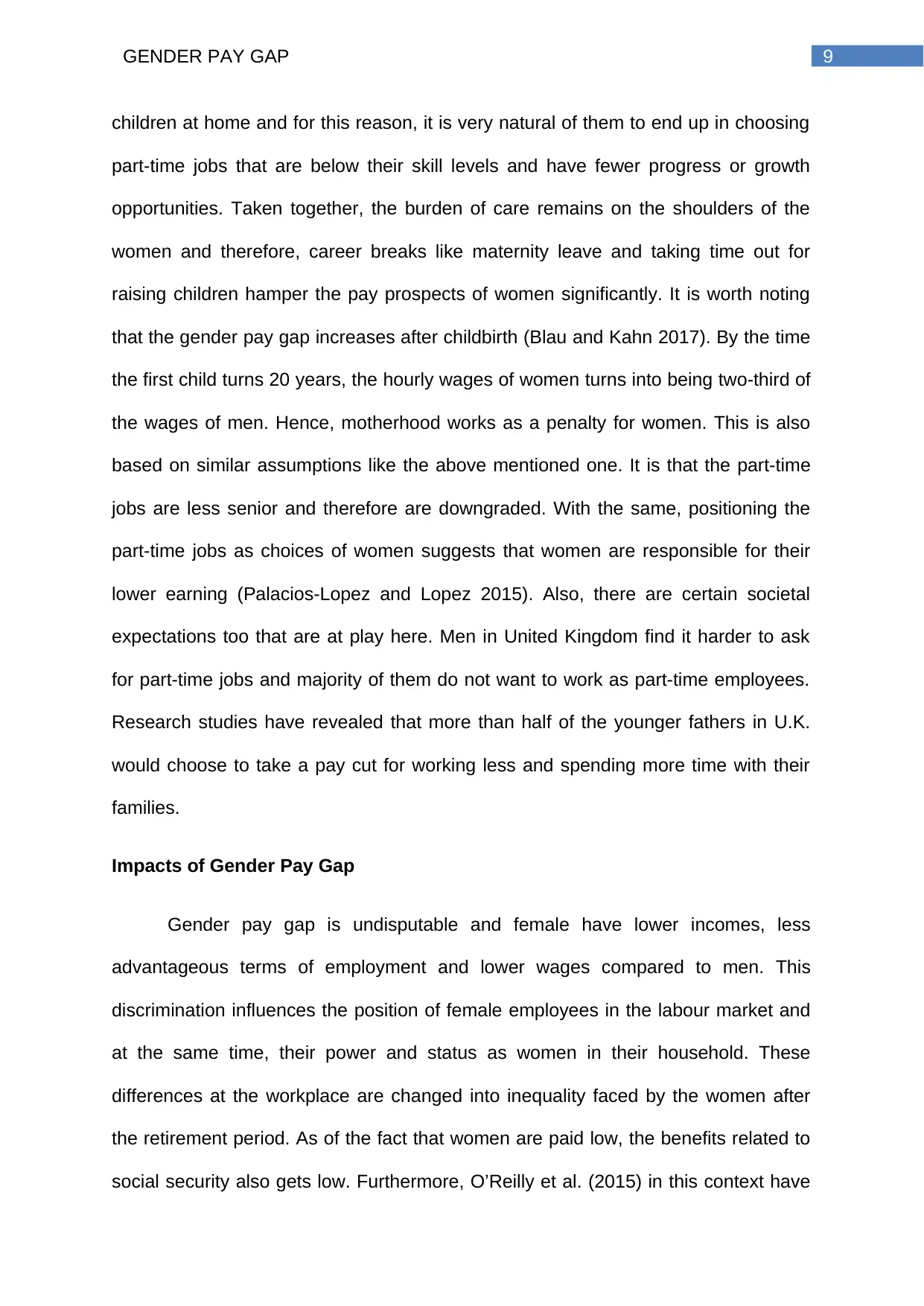
9GENDER PAY GAP
children at home and for this reason, it is very natural of them to end up in choosing
part-time jobs that are below their skill levels and have fewer progress or growth
opportunities. Taken together, the burden of care remains on the shoulders of the
women and therefore, career breaks like maternity leave and taking time out for
raising children hamper the pay prospects of women significantly. It is worth noting
that the gender pay gap increases after childbirth (Blau and Kahn 2017). By the time
the first child turns 20 years, the hourly wages of women turns into being two-third of
the wages of men. Hence, motherhood works as a penalty for women. This is also
based on similar assumptions like the above mentioned one. It is that the part-time
jobs are less senior and therefore are downgraded. With the same, positioning the
part-time jobs as choices of women suggests that women are responsible for their
lower earning (Palacios-Lopez and Lopez 2015). Also, there are certain societal
expectations too that are at play here. Men in United Kingdom find it harder to ask
for part-time jobs and majority of them do not want to work as part-time employees.
Research studies have revealed that more than half of the younger fathers in U.K.
would choose to take a pay cut for working less and spending more time with their
families.
Impacts of Gender Pay Gap
Gender pay gap is undisputable and female have lower incomes, less
advantageous terms of employment and lower wages compared to men. This
discrimination influences the position of female employees in the labour market and
at the same time, their power and status as women in their household. These
differences at the workplace are changed into inequality faced by the women after
the retirement period. As of the fact that women are paid low, the benefits related to
social security also gets low. Furthermore, O’Reilly et al. (2015) in this context have
children at home and for this reason, it is very natural of them to end up in choosing
part-time jobs that are below their skill levels and have fewer progress or growth
opportunities. Taken together, the burden of care remains on the shoulders of the
women and therefore, career breaks like maternity leave and taking time out for
raising children hamper the pay prospects of women significantly. It is worth noting
that the gender pay gap increases after childbirth (Blau and Kahn 2017). By the time
the first child turns 20 years, the hourly wages of women turns into being two-third of
the wages of men. Hence, motherhood works as a penalty for women. This is also
based on similar assumptions like the above mentioned one. It is that the part-time
jobs are less senior and therefore are downgraded. With the same, positioning the
part-time jobs as choices of women suggests that women are responsible for their
lower earning (Palacios-Lopez and Lopez 2015). Also, there are certain societal
expectations too that are at play here. Men in United Kingdom find it harder to ask
for part-time jobs and majority of them do not want to work as part-time employees.
Research studies have revealed that more than half of the younger fathers in U.K.
would choose to take a pay cut for working less and spending more time with their
families.
Impacts of Gender Pay Gap
Gender pay gap is undisputable and female have lower incomes, less
advantageous terms of employment and lower wages compared to men. This
discrimination influences the position of female employees in the labour market and
at the same time, their power and status as women in their household. These
differences at the workplace are changed into inequality faced by the women after
the retirement period. As of the fact that women are paid low, the benefits related to
social security also gets low. Furthermore, O’Reilly et al. (2015) in this context have
Paraphrase This Document
Need a fresh take? Get an instant paraphrase of this document with our AI Paraphraser

10GENDER PAY GAP
claimed that as the inequalities during their working life lead women to get lower
retirement payments. With the same, the inequality in between the earnings of men
and women determine the other negative consequences as well. For instance, as
per Saridakis, Marlow and Storey (2014), lower rate of wages for women can
increase their economic dependence on their male counterparts. This further
increases their susceptibility to face domestic violence.
Equality in terms of economy means different things to different people and
this is more differentiated among men and women (Stoet and Geary 2015). A male
who is in the position of economic independence is the man who does not need to
work for earning a living. On the other hand, a female who is in the position of
economic independence is all about being able of supporting them by means of paid
work so that they are not dependent on their partners. It is to note that there is an
increasing numbers of divorce cases that influence the position of women. The
single mothers are likely to remain as the sole wage earners in their families. It is
very important for understanding the key reasons behind the pay related inequalities
and to seek for the different methods of resolving the issues regarding the gender
pay gap.
Jobs Comparable Worth
According to Yadav and Dabhade (2014), comparable worth refers to the
principle than men and women must be compensated equally for the works that
require comparable skills, efforts and responsibilities. It is also known as pay equity
or sex equity. In simpler terms, it is shorthand for “equal pay for work of equal value
for the work of comparable worth”. It was set by the ILO (International Labour
Organisation) in the year 1951 (Equal remuneration Convention, No. 100; Equal
claimed that as the inequalities during their working life lead women to get lower
retirement payments. With the same, the inequality in between the earnings of men
and women determine the other negative consequences as well. For instance, as
per Saridakis, Marlow and Storey (2014), lower rate of wages for women can
increase their economic dependence on their male counterparts. This further
increases their susceptibility to face domestic violence.
Equality in terms of economy means different things to different people and
this is more differentiated among men and women (Stoet and Geary 2015). A male
who is in the position of economic independence is the man who does not need to
work for earning a living. On the other hand, a female who is in the position of
economic independence is all about being able of supporting them by means of paid
work so that they are not dependent on their partners. It is to note that there is an
increasing numbers of divorce cases that influence the position of women. The
single mothers are likely to remain as the sole wage earners in their families. It is
very important for understanding the key reasons behind the pay related inequalities
and to seek for the different methods of resolving the issues regarding the gender
pay gap.
Jobs Comparable Worth
According to Yadav and Dabhade (2014), comparable worth refers to the
principle than men and women must be compensated equally for the works that
require comparable skills, efforts and responsibilities. It is also known as pay equity
or sex equity. In simpler terms, it is shorthand for “equal pay for work of equal value
for the work of comparable worth”. It was set by the ILO (International Labour
Organisation) in the year 1951 (Equal remuneration Convention, No. 100; Equal
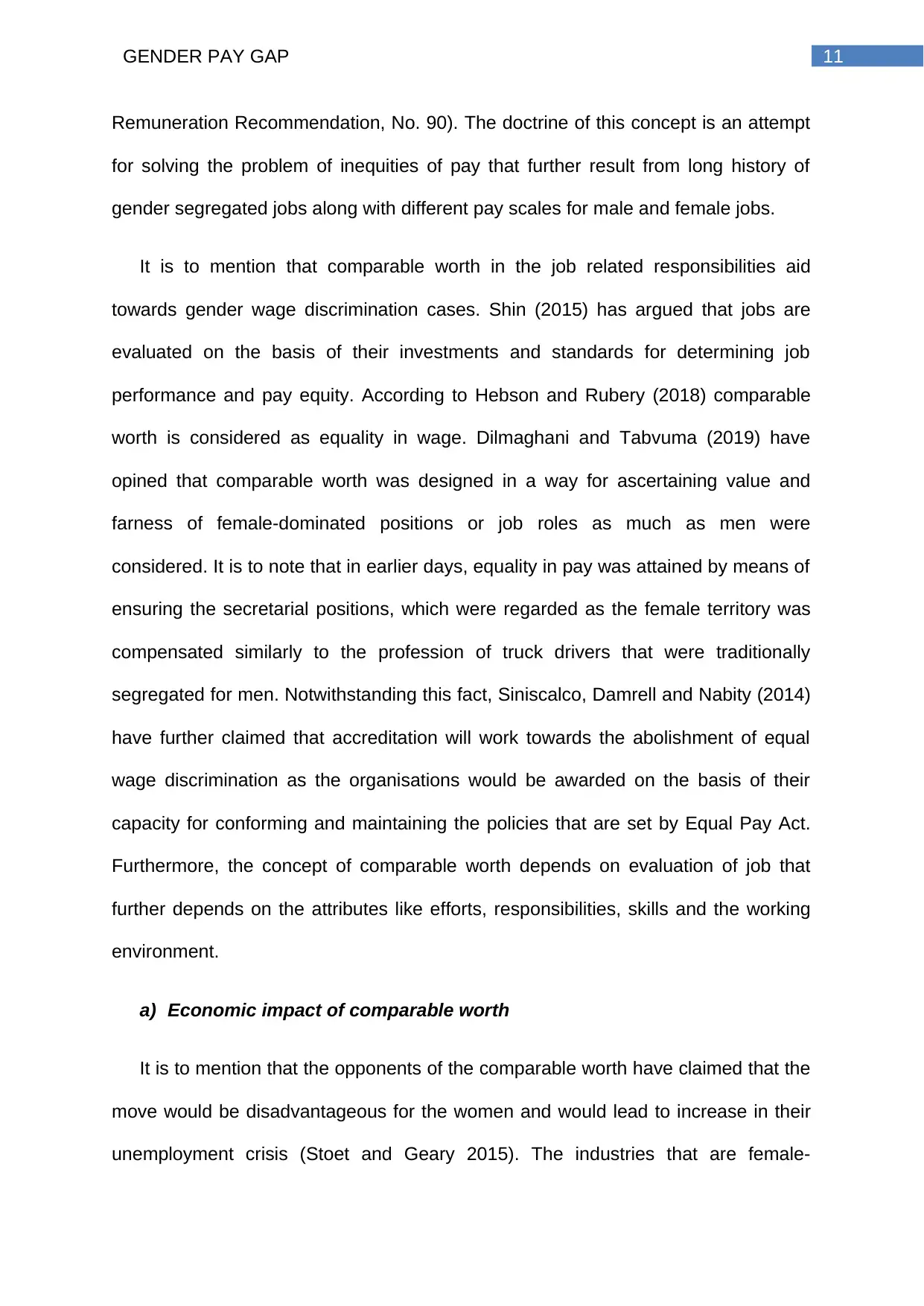
11GENDER PAY GAP
Remuneration Recommendation, No. 90). The doctrine of this concept is an attempt
for solving the problem of inequities of pay that further result from long history of
gender segregated jobs along with different pay scales for male and female jobs.
It is to mention that comparable worth in the job related responsibilities aid
towards gender wage discrimination cases. Shin (2015) has argued that jobs are
evaluated on the basis of their investments and standards for determining job
performance and pay equity. According to Hebson and Rubery (2018) comparable
worth is considered as equality in wage. Dilmaghani and Tabvuma (2019) have
opined that comparable worth was designed in a way for ascertaining value and
farness of female-dominated positions or job roles as much as men were
considered. It is to note that in earlier days, equality in pay was attained by means of
ensuring the secretarial positions, which were regarded as the female territory was
compensated similarly to the profession of truck drivers that were traditionally
segregated for men. Notwithstanding this fact, Siniscalco, Damrell and Nabity (2014)
have further claimed that accreditation will work towards the abolishment of equal
wage discrimination as the organisations would be awarded on the basis of their
capacity for conforming and maintaining the policies that are set by Equal Pay Act.
Furthermore, the concept of comparable worth depends on evaluation of job that
further depends on the attributes like efforts, responsibilities, skills and the working
environment.
a) Economic impact of comparable worth
It is to mention that the opponents of the comparable worth have claimed that the
move would be disadvantageous for the women and would lead to increase in their
unemployment crisis (Stoet and Geary 2015). The industries that are female-
Remuneration Recommendation, No. 90). The doctrine of this concept is an attempt
for solving the problem of inequities of pay that further result from long history of
gender segregated jobs along with different pay scales for male and female jobs.
It is to mention that comparable worth in the job related responsibilities aid
towards gender wage discrimination cases. Shin (2015) has argued that jobs are
evaluated on the basis of their investments and standards for determining job
performance and pay equity. According to Hebson and Rubery (2018) comparable
worth is considered as equality in wage. Dilmaghani and Tabvuma (2019) have
opined that comparable worth was designed in a way for ascertaining value and
farness of female-dominated positions or job roles as much as men were
considered. It is to note that in earlier days, equality in pay was attained by means of
ensuring the secretarial positions, which were regarded as the female territory was
compensated similarly to the profession of truck drivers that were traditionally
segregated for men. Notwithstanding this fact, Siniscalco, Damrell and Nabity (2014)
have further claimed that accreditation will work towards the abolishment of equal
wage discrimination as the organisations would be awarded on the basis of their
capacity for conforming and maintaining the policies that are set by Equal Pay Act.
Furthermore, the concept of comparable worth depends on evaluation of job that
further depends on the attributes like efforts, responsibilities, skills and the working
environment.
a) Economic impact of comparable worth
It is to mention that the opponents of the comparable worth have claimed that the
move would be disadvantageous for the women and would lead to increase in their
unemployment crisis (Stoet and Geary 2015). The industries that are female-
⊘ This is a preview!⊘
Do you want full access?
Subscribe today to unlock all pages.

Trusted by 1+ million students worldwide
1 out of 21
Related Documents
Your All-in-One AI-Powered Toolkit for Academic Success.
+13062052269
info@desklib.com
Available 24*7 on WhatsApp / Email
![[object Object]](/_next/static/media/star-bottom.7253800d.svg)
Unlock your academic potential
Copyright © 2020–2025 A2Z Services. All Rights Reserved. Developed and managed by ZUCOL.




